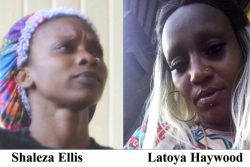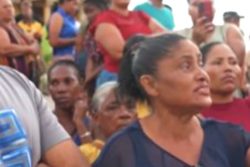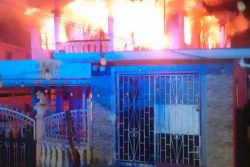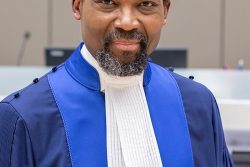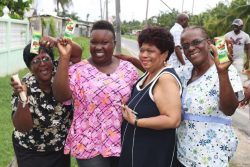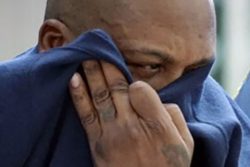A talk given by Stanley Greaves to students of the Critchlow Labour College in Georgetown, Guyana on Tuesday, October 2, 2007.
It is a pleasure indeed to be here in an institution that has served Guyana well since the year of its inception in 1967, to share with you an issue which, as far as I am aware, has never been addressed. I am referring to the continuing contribution made by artists of a working class background to the development of the practice of art in Guyana.
History records the struggle of the working class in the early 20th century in the Caribbean to bring attention to just needs as regards working conditions. It was a period of world-wide solidarity for workers at all levels of industry. Labour leaders in the Caribbean were not to be left behind in the struggle. The formation of unions became paramount. Workers’ rights had to be discussed and negotiated with management. In my childhood the name ‘Critchlow’ was often heard in discussions between my father John Greaves and his waterfront worker friends on the organization of waterfront workers.
Much later on another name was brought to my attention by a school friend. It was that of Edward Rupert Burrowes. The organization he formed in 1948 was called the Working Peoples’ Free Art Class (the ‘Free’ was soon dropped from the title). I joined the following year when I was fifteen. The name he chose brought the class to the attention of the police. In those pre-independence days the top command was British. The socialist revolution in Russia and the formation of socialist oriented unions world wide was the cause of great concern in Britain given the power of British unions united under the Trades Union Council. Two police detectives were sent to join the class to see if Burrowes was forming some kind of communist or socialist cell disguised as an art class. The fact that he received the socialist news paper The Daily Worker from Britain added to their suspicion. I learnt all this many years later from Inspector John Campbell, who was one of the detectives sent to join the class. Campbell discovering that he liked drawing and painting remained in the class and took part in exhibitions.
Burrowes himself was of lower middle-class origins. He was born in Barbados in 1903 and was brought to British Guiana as a baby. His father worked for the Daily Chronicle located in Main Street opposite the Tower Hotel. In those days the paper was privately run. After the death of his father an unscrupulous lawyer took advantage of the family and they were forced to live under reduced circumstances. Burrowes was an intelligent young man gifted in art, who on leaving primary school was apprenticed to a tailor. He could not afford to buy paints so he would make his own using tailor’s chalk.
He took the City and Guilds examinations and became the youngest person to pass at advanced level. He progressed to the extent of opening his own tailoring establishment. While he did not attend secondary school he was a voracious reader who studied for and passed examinations that included English Language and Literature, English History, and Scripture. Throughout all this his fascination with art remained.
Burrowes subsequently joined the British Guiana Arts and Crafts Society (BGACS) which was formed in 1932. Exhibitions were held annually at Christmas in the Freemason Hall. The Governor who was patron declared shows open. His obvious talent caught the attention of older members and he excelled in landscape painting as well as genre painting – a technical term meaning everyday scenes involving people. His subject matter was always based on the working class, and he received great praise for a small painting entitled Sunday Morning Tenement Yard. The name of the BGACS is of some significance. In 19th century England the Industrial Revolution created the mass production of goods formerly made by artisans and craft workers, and the market was flooded with goods of inferior design. An artist and craftsman, William Morris, decided to do something about this and founded the Arts and Crafts Society of Great Britain. A chair he designed was even named after him.
Morris organized groups of working class artisans to design and make all kinds of household goods. Burrowes, from reading art history, found a kindred spirit in Morris and his dedication to the working class. He regarded the BGACS as a middle-class organization, which it was, even though a few working-class types were members. These were Hubert Moshett, employed as a graphic artist; Sam Cummings and Basil De Freitas, who were sign painters; David Singh and Claude Hoyte. Burrowes felt that the urge and ability to express oneself in art had no class distinction, and that working-class individuals should be afforded an opportunity to discover and give expression to this ability. This was the rationale for the formation of the Working People’s Art Class (WPAC).
Burrows and his WPAC caught the attention of the British Council, which offered annual help in the form of ?50 worth of art materials not obtainable in Guyana. Twice he attended art schools in England on British Council scholarships. He was on the Queen’s birthday honours list and awarded the title of MBE (Member of the British Empire) in the late 1950s. Because of his strength as a debater and public speaker and his commitment to the working class, he was even invited by Cheddi Jagan to join the PPP and contest a seat in the first general elections of 1952; Burrowes did not accept the invitation, preferring to serve art. In the middle 1960s he did produce the statue of Critchlow which is located in the compound of the Public Buildings. Burrowes devoted most of his life teaching others to the extent of neglecting his own considerable talent as painter and sculptor. He died in 1966.
Most of the members of the WPAC practised art as a hobby. The themes chosen were based mainly on working-class life and landscapes. A few who were interested in Art History were more adventurous and attempted work in the international Modernist styles of the time. The work of the class was to a large extent ignored by the general public, who lacked and still do, some kind of education in the purpose of artistic activity in the life of a people or nation. The class did not have a fixed meeting place, but moved from one location to the next. Annual exhibitions which created excitement among members were held at Easter in the St.Andrews School hall.
The first location was the ‘Auditorium’ in Charlotte Street near Camp Street (destroyed by fire in the 1980s). It was a two-storied building with the upper story open all around. Public events like parties, weddings, dances and meetings were held there. It was also a popular venue for weightlifting and body-building contests. The class met on the ground floor which during the day accommodated a small private high school, whose principal was probably a friend of Burrowes. Classes in drawing were held on Thursday evenings and painting on Saturday afternoons.
In 1949 Burrowes was awarded a British Council Art Scholarship to study in England for a year. The class was then left in charge of Basil Hinds, Headmaster of Dolphin Government Primary School and Donald Locke who was teaching art there. On his return Burrowes was appointed Art teacher at the Government Teachers’ Training College. The class then moved to a building which was used as a high school – Modern High School located in upper Robb Street just over Light Street. We had access to the middle floor where there were several rooms. One room was designated for drawing from the model, usually one of the members. Another room was for those working on still-life compositions based on everyday objects, usually stored in a large brown painted wooden chest referred to as the ‘Jumby Tool Box.’ Those who preferred to do work from the imagination would sit anywhere.
From here the third move was to Smith’s Church Congregational School in Hadfield Street near Camp. The WPAC remained here the longest. By this time the cl
ass had divided itself into three groups. Some members continued landscape and genre painting. The traditionalists studied the work and methods of European Old Masters from books, while the Modernists followed trends in Modern Art. This often led to heated but friendly arguments between the two groups as to which artists were the greatest. Anyone listening would have come to the conclusion that the works of the artists being studied had been seen and studied first hand.
It must be said that despite the limitations both groups took their work seriously and were always on the lookout for good books and art magazines. At that time – the middle to late 1950s – the only art magazine available was The Studio (later re-named The Studio International) published in Britain. We were therefore well informed as to trends in Britain and Europe. The magazine was actually obtained from the British Council Library. Burrowes on his return from his second period of studying art in England was inexplicably appointed as a school attendance officer on the East Coast. The work he did abroad and his experiences at the St Martin’s School of Art – the leading school of the time – created great interest among most members. The Guyanese Art Group by this time had been disbanded and the WPAC became the only functioning art group.
The final move of the WPAC was to the Art Room at Queen’s College, where Burrowes was appointed Art Master. By this time the membership had dwindled. It had also lost its original working-class character and had become more of a hobby group for most of the remaining members. Individual artists, some from the working class who were not members of the WPAC, would still seek out Burrowes to show work for his criticism and encouragement. By 1961 the class had ceased to exist. Despite the activities of both groups they never managed to capture the public’s imagination. This was due to the absence of trained art teachers in schools, a situation that still holds true today.
In the 1970s I was contacted by Mr Profitt, who was head of the Adult Education Association about the organization of art classes. The AEA was founded to help working-class adults to improve their education in academic and technical subjects of all kinds. For about three years I conducted classes in drawing, calligraphy and a specialized course in book illustration for the Ministry of Education. At the time it was pioneering the production and use of books for the primary schools written and illustrated by Guyanese. It was a most welcome and commendable effort. Most of the applicants for that class were from the working class.
In 1975 Denis Williams, himself an artist, who was the Director of Art in the Ministry of Education and Culture established the Burrowes School of Art (BSA). From its inception the BSA attracted working-class students most of whom did not have a secondary school education. This created problems in the teaching of theoretical subjects that required a background in language, literature, maths and history. Remedial classes had to be organized so that students could benefit from what was being offered in theoretical courses. It can be demonstrated that having talent for art is not enough. It has to be supported by specialized education in the subject along with supporting studies in the humanities if any substantial progress is to be made. There are very few exceptions to this in Guyana and Phillip Moore is the most notable. His work known at home and abroad is exemplary.
The need for self expression is not restricted to the creative arts, but has a place in everything we do. As far as art is concerned the working class in Guyana continues to produce artists. Despite the non-existence of strong support in the community the activity persists as evidenced by the work of the late Compton Parris and Omowale Lumumba, and at present by Gary Thomas and Winston Strick, among others. When internal need demands expression it will always find a way to do this despite limitations.
Finally, it should be said that the success of a nation depends not only on the development of material resources but equally so on the use of the imagination and spirit of its people. Any system of education that neglects the development of the imagination and creativity in all areas of endeavour is doing the nation a great disservice. Dr Roopnaraine as head of the Critchlow Labour College is to be congratulated, therefore, for his efforts in organizing this series of monthly lectures and talks on a wide range of subjects for the benefit of students. It is to be hoped that by so doing students will be able to use information from a range of sources to their area of specialization.
I would also like to extend my gratitude to Elfrieda Bissember, the Director and Curator of the National Collection, for her prompt response in setting up the special exhibition by working-class artists providing essential support the theme of the talk.

